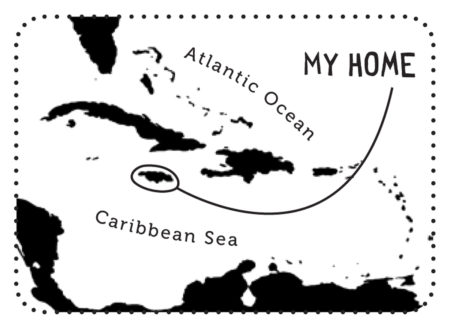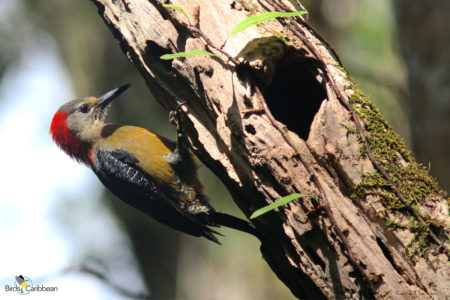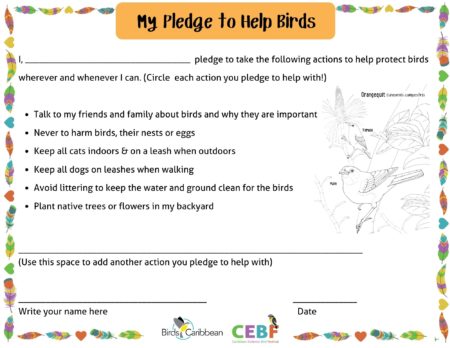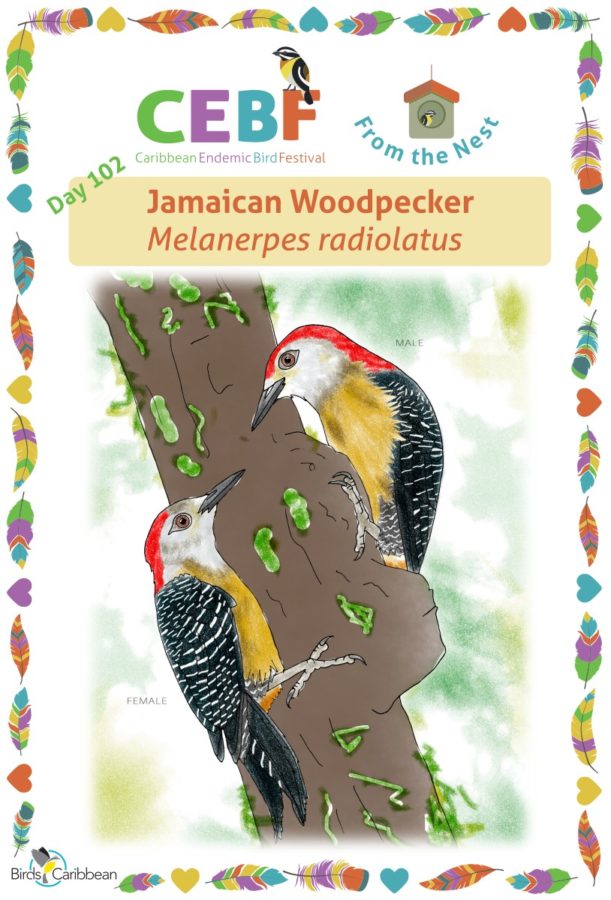Celebrate the Caribbean Endemic Bird Festival (CEBF) with us! Our theme in 2022 is “Loving Birds is Human Nature”. Have fun learning about a new endemic bird every day. We have colouring pages, puzzles, activities, and more. Download for free and enjoy nature with your family at home.
Endemic Bird of the Day: Jamaican Woodpecker
 In Jamaica, most early mornings boast the iconic soundtrack of the Jamaican Woodpecker at work – boring holes in dead trees or light poles.
In Jamaica, most early mornings boast the iconic soundtrack of the Jamaican Woodpecker at work – boring holes in dead trees or light poles.
Endemic to Jamaica, this bird can be found throughout the island, from the coast to the highest point, 2256m in the Blue Mountains. They are also tolerant to human disturbance, often found in gardens in more urban areas, such as the capital Kingston.
The Jamaican Woodpecker has a red hind neck, white face, and pale underparts with a yellow wash, upperparts and wings are generally black and densely streaked with white and the tail is blackish. Males and females can be easily identified by their forecrown. Males sport a striking red forecrown, while females have a brownish-olive forecrown. Size ranges from 24 to 26 cm. Jamaican Woodpeckers tend to travel alone, but are also observed in pairs or small groups. Their main diet consists of insects on the surface of trees or fruits. They are often seen feeding on the Ackee (Blighia sapida), the national fruit of Jamaica, and commonly also foraging in epiphytes for insects.
Breeding typically occurs from December to August, sometimes in other months. Nests are excavated at ~5–15 m in the trunk or branch of a dead tree or in a utility pole. Clutch size is usually 3–5 white eggs, laid at daily intervals. Incubation is performed by both sexes.
Jamaican Woodpeckers are very loud and vocal, making an auditory detection perhaps more frequent than a sighting. The main call is rolling churp churp churp, however, one call given frequently is very similar to the crok! of a Black-crowned Night-heron (Nycticorax nycticorax).
The Jamaican Woodpecker is listed as a Least Concern by the IUCN, however the long-term survival of this single-island endemic is threatened by loss of forest habitat due to deforestation. Learn more about this species, including its range, photos, and calls here.
Colour in the Jamaican Woodpecker
Download our West Indies Endemic Bird colouring page. Use the photos below as your guide, or you can look up pictures of the bird online or in a bird field guide if you have one. Share your coloured-in page with us by posting it online and tagging us @BirdsCaribbean #CEBFfromthenest
Listen to the calls of the Jamaican Woodpecker
The calls of the Jamaican Woodpecker emphatic, slightly rasping “urp“
Puzzle of the Day
Click on the image below to do the puzzle. You can make the puzzle as easy or as hard as you like – for example, 6, 8, or 12 pieces for young children, all the way up to 1,024 pieces for those that are up for a challenge!


Activity of the Day
 FOR KIDS: We hope that you have enjoyed learning all about our Caribbean endemic birds! Sadly some of the birds we have featured are endangered and many others are under pressure, often from human activities. This means our special endemic birds and many of the other beautiful birds that live in or visit us in the Caribbean need your help. Even simple things like picking up litter or being sure never to disturb birds when they are feeding, resting and nesting can make a difference.
FOR KIDS: We hope that you have enjoyed learning all about our Caribbean endemic birds! Sadly some of the birds we have featured are endangered and many others are under pressure, often from human activities. This means our special endemic birds and many of the other beautiful birds that live in or visit us in the Caribbean need your help. Even simple things like picking up litter or being sure never to disturb birds when they are feeding, resting and nesting can make a difference.
You can download and print our pledge to help birds. Then sign your name and get started helping our birds by following some of the simple actions listed in the pledge. You can also colour in the picture on the pledge and perhaps hang it up somewhere at home to remind you and others of how you can help birds.
You can look at all the Caribbean endemic birds we have featured so far, from all our Caribbean Endemic Bird Festivals here.
FOR KIDS AND ADULTS: Enjoy this video of a Jamaican Woodpecker the wild!

